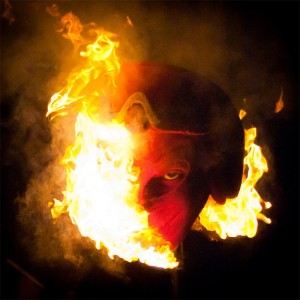The Intangibility of Inspiration
GALO: Conversely, is there a piece you would consider to be the most difficult you’ve ever made?
DM: We just made a couple of sculptures for a town in northern Italy: Vinadio. Two quite large figures, initially intended to be made out of coiled steel, rather Gormley/Michelin Man-esque. They were a pain in the arse to make. Every step required a new system of making, with endless amounts of finishing, all fitting between casting, molding, modeling, construction and, like I say, so much finishing.
GALO: When protesting your work Polaris in the 1980s, a person who attempted to light the sculpture on fire suffered fatal burns and died. Did you intend your piece to be so controversial? What kind of impact did this person’s death have on you as an artist? Did you “tone down” the political message of your art afterward?
DM: That work didn’t have an outright political message; it wasn’t an anti-nuclear stance or anything like that. The “protestor” was a guy who was mentally ill, so it really wasn’t a protest on his part either. Unfortunately, the poor guy died as a result of the fire that he made. I was sad for him and his family, it’s a horrible way to die, but I didn’t really think that it had much to do with me or my sculpture.
I certainly don’t tread carefully or tone things down; I like to be full on.
GALO: Many of your works, such as Brick Train, are quite large. Why do you choose such a large scale with your sculptures?
DM: It’s to do with where I grew up, everything around me was massive: the landscape, the country, the beaches, [and] the industry. I grew up sandwiched between an actual brickworks, a slag heap (bing in Scottish), a power station, the docks, a yard where they made steel vessels for the whiskey industry, another yard where they made oil platforms which were just f—ing enormous, the football stadium, a vast whiskey bond, etc., etc., etc.
Everywhere I looked, people were beavering away like crazy. I thought, genuinely, that I lived in the center of the universe.
GALO: Is there a favorite medium you like to work with? Why?
DM: It is pins for now; we’re just beginning to wade through our five million. But as I say, I’m a materials addict, a junkie for stuff. Whatever I’m using, I just don’t seem to be able to get enough of the stuff.
GALO: You’ve been a professor at the Royal Academy of Arts since 2000. How is teaching art different than being a student of art, or do you think they are similar?
DM: Teaching is entirely different, and thankfully, I barely step foot in the Royal Academy. I prefer to teach by working on collage or sculpture with whatever material. You can’t beat working with people, actually on something, for learning. Everybody learns, including me, and not just about art either.
GALO: You’ve won numerous awards for your work. Has your success added any pressure to meet expectations, either your own or those of others?
DM: I don’t feel particularly successful and, I suspect, I pressure myself more than I respond to outside sources.
GALO: What are you currently working on?
DM: Pin vases, dogs, love hearts, flat work, and — this I’m really looking forward to — a voodoo doll. We’re also making quite a few coat hanger pieces including a 14-foot-tall rearing stallion.
GALO: What do you see yourself doing in the future?
DM: More bloody art, I should think. I’ve come into music recently too though. I’m the drummer in a band called The Voyeurz! That I find incredibly creative and, as a bonus, it’s led me to write lyrics and [I am] now writing poetry and I’ve [also] started working on a couple of short stories. I’m planning a lot for this particular activity and I’m giving my first public recital of my poetry in September.
GALO: Anything else you’d like to say?
DM: Look out for the new pin work, look out for The Voyeurz, look out for an anthology of poetry and some short stories!
Video courtesy of David Mach. For more videos on “Precious Light” or other works visit: www.davidmach.com.

